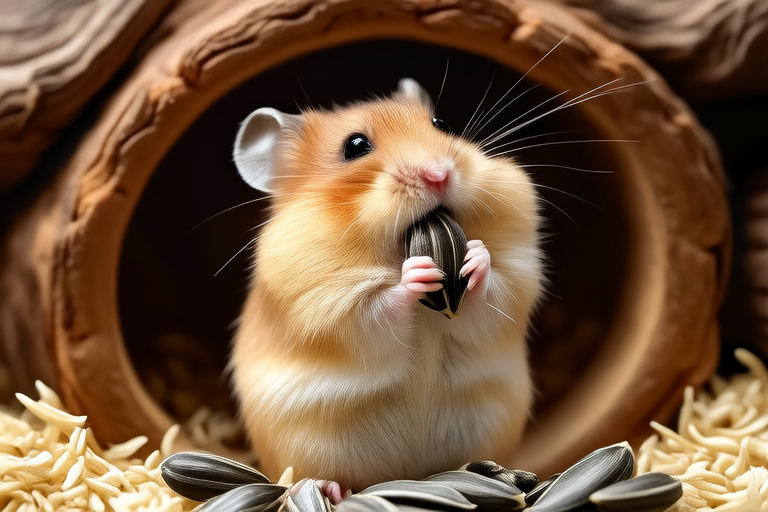Unraveling Hamster Behavior: Decode Their Actions Like a Pro!
Welcome to the fascinating world of hamsters! These small, furry creatures are not just adorable pets but also intriguing companions with unique behaviors that can tell us much about their well-being. Understanding these behaviors is key to providing them with the best possible care. In this article, we’ll delve into the common behaviors of hamsters, including wheel running, hoarding, and nocturnal activities, and explain what they mean for your pet’s health and happiness.
The Enigmatic Wheel Runner
One of the most iconic images associated with hamsters is that of a tiny rodent running tirelessly on its exercise wheel. This behavior is not just about keeping fit; it’s a vital part of their daily routine. Hamsters are naturally active animals, and their need for physical activity is essential for their mental and physical health. A wheel serves as an outlet for this energy, helping to prevent obesity and stress.
However, excessive wheel running might indicate underlying issues. If your hamster runs non-stop, it could be a sign of boredom or anxiety. Providing additional toys and tunnels can help reduce this behavior. On the other hand, if your hamster suddenly stops using the wheel, it might be experiencing discomfort or illness. Monitoring their activity level can give you valuable insights into their overall health.
The Hoarder Within
Hamsters have a notorious reputation for hoarding food. This behavior stems from their wild ancestors who needed to store food for lean times. While it’s natural for a hamster to gather snacks, it’s crucial to ensure they don’t overdo it. Over-hoarding can lead to weight gain and digestive issues.
To manage this behavior, offer a variety of healthy foods and monitor the amount of food you provide. Rotate different types of treats to keep them interested without encouraging excess hoarding. Additionally, regular cage cleaning can help you check on their hoarding habits and ensure they’re not consuming old or spoiled food.
Anecdote: One owner shared that her hamster would stash food under her bed, leading to an unexpected discovery during a spring cleaning. This highlighted the importance of checking less obvious areas when cleaning the house.
Nocturnal Night Owls
Hamsters are primarily nocturnal, meaning they are most active during the night. This can sometimes pose challenges for owners who are more active during the day. Understanding and respecting their natural sleep cycle is important for maintaining a harmonious relationship.
During their active period, hamsters will explore their environment, interact with toys, and engage in social activities if kept in pairs. It’s essential to provide stimulating environments to keep them engaged. During the day, they usually sleep deeply, so it’s best to avoid handling them unless necessary.
If your hamster seems unusually inactive during the night, it could indicate a problem. Health issues, stress, or changes in their environment might disrupt their normal schedule. Observing their nighttime behavior can be a great way to catch potential problems early.
Decoding Other Common Behaviors
Aside from wheel running, hoarding, and nocturnal activity, hamsters exhibit various other behaviors that can provide insights into their lives.
- Gnawing: Hamsters’ teeth grow continuously, so they need to gnaw to keep them at a manageable length. Providing safe, appropriate chew toys is essential to prevent dental issues.
- Bathing: Contrary to popular belief, hamsters do not take water baths. Instead, they clean themselves by grooming, similar to cats. Regular grooming ensures their coat remains healthy and free of parasites.
- Squeaking: Squeaks can range from a sign of excitement to a call for attention. Pay attention to the context in which your hamster squeaks to understand its meaning.
Tips for Interpreting Hamster Behavior
Interpreting your hamster’s behavior correctly can significantly enhance your ability to care for them effectively. Here are some tips to help you become a pro at decoding their actions:
- Observe Consistently: Spend time watching your hamster in their natural environment. Consistent observation helps you notice changes in behavior that might signal health issues.
- Learn Normal Patterns: Every hamster has its own personality and normal behavior patterns. Familiarizing yourself with these can help you spot deviations easily.
- Engage with Your Pet: Spend quality time with your hamster. Play, training sessions, and gentle handling can strengthen your bond and provide opportunities to observe their behavior closely.
- Consult Experts: If you’re unsure about certain behaviors or notice concerning changes, don’t hesitate to consult with a veterinarian or a hamster expert.
Conclusion
Understanding hamster behavior is a rewarding journey that deepens the bond between you and your pet. By recognizing and responding to their unique behaviors, you can ensure they lead happy, healthy lives. Remember, each hamster is an individual with its own preferences and quirks. Stay observant, stay curious, and enjoy the adventure of unraveling the mysteries of hamster behavior.
